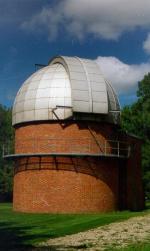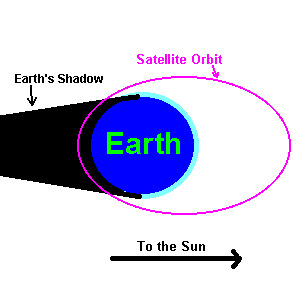| Warner and Swasey Observatory |
| Case Western Reserve University | Nassau Station |
| Visitors |
|
» Home » News » Gallery » Reference » Weather |
| Science Resources |
|
» NSRT User Interface » Software » Data Archive » Download Data |

|
 |
Viewing Satellites
Can I look at a satellite with a telescope?
Our telescope, the Nassau Station Robotic Telescope, is not able to view satellites. A satellite moves rather quickly across the sky (often faster than a jet plane at 30000 ft) and the NSRT is not set up to track that quickly across the sky. The best one can hope for is to point the NSRT at one place and hope that a satellite briefly streaks through the field. However this is very unlikely and we discourage people from submitting proposals to do that.
The only large telescopes that can track and take pictures of satellites in earth orbit are owned by the United States Air Force at the Starfire Optical Range in New Mexico. These telescopes are not available to the general public.
If you are a determined do-it-yourself-er one can modify their 8"-10" telescope they use in their back yard to track and image satellites in low earth orbit. This project is not one to be undertaken by the amateur with a casual interest. While it is doable, it is very difficult. If you are successful in putting a satellite imaging system like this together you can probably count on a visit from your friendly neighborhood National Security Agency to check it out.
Viewing satellites without a telescope
You don't need a telescope to view satellites. If you pick a dark site outside of the city, you can often see several criss-cross the sky a few hours after sunset and before sunrise. With all the stuff up there in Earth orbit these days, at the right time of night you'll see as many satellites and meteors on a normal night. There are a few things you should know before you go out an try looking for them.
- What does a satellite look like?
- A satellite will appear as a star-like dot crossing the sky in an arc. The speed which the satellite appears to move at depends on how high it is above the Earth, but most will move at about the speed of a jet plane cruising over head. Some may appear to get brighter and fainter as they tumble or spin and some may disappear while crossing the sky as they pass into the Earth's shadow.
- When should I look for satellites?

- The cartoon above shows a simple picture of a satellite's obit around the Earth. The Sun is off the diagram to the right, so the Earth's shadow is cast to the left of the Earth as we look down on the north pole. The only time we can see a satellite is when the sun is hitting it and it is reflecting light. (Just like the Moon, which doesn't shine with its own light but the reflected light from the Sun.)
During the day time it is hard to see satellites because the sky is bright, so we have to wait until the sun has gone down (when our place on Earth has turned away from the Sun into the Earth's shadow). So the best time to view satellites is when they are over our heads outside of the Earth's shadow, while we are in the Earth's shadow. This occurs for a few hours after sunset and a few hours before sunrise.
Sometimes while you are watching a satellite arc across the sky it will blink out and disappear. This is probably because it entered the Earth's shadow as it traveled over head.- The cartoon above shows a simple picture of a satellite's obit around the Earth. The Sun is off the diagram to the right, so the Earth's shadow is cast to the left of the Earth as we look down on the north pole. The only time we can see a satellite is when the sun is hitting it and it is reflecting light. (Just like the Moon, which doesn't shine with its own light but the reflected light from the Sun.)
- How do I know what satellites I might see if I go outside tonight?
- There are many web sites available to check on the visibility of satellites at your location. All you have to know is the latitude and longitude of you place on the Earth. (Although some sites will compute the observing information for a city or town without giving it a latitude and longitude.) Here is a partial list of some good sites: